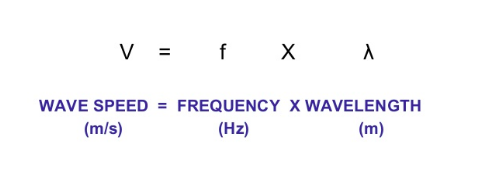Waves - The Basics
What are waves?
⇒ A wave is just a way of transferring energy without actually transferring matter
- For example, if you throw a ball into a pond, that ball will cause ripples (i.e. waves) moving through the water. But the ball itself is going to stay in the middle of the water. Likewise, the water itself isn't going to be moving away from the tennis ball, it's just the waves that are moving away
- All the matter stays in place, it just oscillates up and down
Properties of waves

⇒ This wave is an example of a transverse wave: transverse waves oscillate up and down and have various properties
⇒ The top of the wave is called the crest and the bottom of the wave is called the trough
⇒ The middle line is the central undisturbed position, and the molecules are displaced up and down about this central point
- Crests are the point of maximum displacement upwards, and troughs are the point of maximum displacement downwards
⇒ The wavelength is the distance between two similar points on the wave e.g. between two crests or troughs
- The wavelength is just the length of one complete cycle of the wave
⇒ The amplitude is just the height of the wave i.e. the height from the central undisturbed position
⇒ The frequency of a wave is how many times per second it makes one complete cycle i.e. the number of oscillations per second
- You can also think of frequency as how many full waves travel through a certain point every second
- Frequency is measured in hertz (Hz) - 1 hertz is just a way of saying 1 complete cycle is completed in 1 second
- So if you have 500 waves travelling through a certain point every second then that wave has a frequency of 500Hz
⇒ The period of the wave is how long it takes to complete one oscillation i.e. how long it takes for a whole wave to pass through a certain point
- This is measured in seconds
The Wave Equation

Transverse and Longitudinal Waves

Transverse Waves
⇒ The oscillations are perpendicular to the direction of energy transfer
- In other words, the direction of energy transfer is forwards, and it is oscillating up and down at 90 degrees to that direction of energy transfer
⇒ Example of transverse waves include electromagnetic waves (such as light), ripples in water when you drop a ball into it, waves on a string when you shake it up and down
Longitudinal Waves
⇒ Here it is compressions that are moving through the medium: the oscillations are parallel to the direction of energy transfer
⇒ With a longitudnal waves you have areas of compression (where the lines are close together) and stretched out areas (i.e. areas of rarefaction)
⇒ Examples include sound waves (as they travel as compressions through the air), ultrasound (very high pitch sound waves), certain types of seismic waves